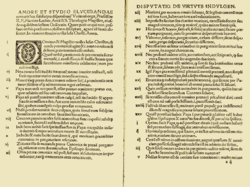Reformator Protestan
| Bagian dari seri |
| Reformasi Protestan |
|---|
 |
| Protestanisme |
| Bagian dari seri |
| Protestanisme |
|---|
 |
|
|
Reformator Protestan adalah para teolog yang karier, karya, dan tindakannya melahirkan Reformasi Protestan pada abad ke-16.
Dalam konteks Reformasi, Martin Luther adalah reformator pertama yang menyampaikan pandangannya secara terbuka pada tahun 1517, diikuti oleh Andreas Karlstadt dan Philipp Melanchthon di Wittenberg, yang segera bergabung dengan gerakan baru tersebut. Pada tahun 1519, Huldrych Zwingli reformator pertama yang mengekspresikan sebuah bentuk tradisi Reformed .
Berikut ini hanyalah para reformator yang paling berpengaruh. Mereka didaftar berdasarkan gerakan, meskipun beberapa reformator mempengaruhi berbagai gerakan dan dimasukkan ke dalam masing-masing bagian.
Pendahulu yang terkemuka[sunting | sunting sumber]
Selama Abad Pertengahan, menurut Edmund Hamer Broadbent, terdapat sejumlah gerakan Kristen yang berusaha untuk kembali ke apa yang mereka anggap sebagai kemurnian gereja Apostolik dan yang ajaran-ajarannya menjadi bayang-bayang ide-ide Protestan.[1]
- Claudius dari Turin[2]
- Gottschalk dari Orbais[3][4][5]
- Berengar dari Tur[6][7][8]
- Peter Waldo[9]
- Lorenzo Valla[10]
- Wessel Gansfort[11]
- Girolamo Savonarola
- Jacques Lefèvre d'Étaples[12]
- John Wycliffe[13]
- Jan Hus[14]
Reformator Magisterial[sunting | sunting sumber]

Ada sejumlah reformator utama dalam Reformasi Magisterial, termasuk:
Lutheran[sunting | sunting sumber]
- Martin Luther
- Philipp Melanchthon
- Justus Jonas
- Martin Chemnitz
- Georg Spalatin
- Joachim Westphal
- Andreas Osiander
- Johannes Brenz
- Johannes Bugenhagen
- Andreas Karlstadt, yang kemudian menjadi Reformator Radikal
- Hans Tausen
- Mikael Agricola
- Primož Trubar
- Jiří Třanovský
Reformed[sunting | sunting sumber]
- Huldrych Zwingli
- Martin Bucer
- John Calvin
- Heinrich Bullinger
- Theodore Beza
- William Farel
- John Knox
- Wolfgang Capito
- Johannes Oecolampadius
- Pietro Martire Vermigli
- Leo Jud
Anglikan[sunting | sunting sumber]
Arminian[sunting | sunting sumber]
Unitarian[sunting | sunting sumber]
Reformator Radikal[sunting | sunting sumber]
Para reformator penting dalam Reformasi Radikal meliputi:
Anabaptis[sunting | sunting sumber]
Schwenkfelder[sunting | sunting sumber]
Reformator Front Kedua[sunting | sunting sumber]
Ada juga sejumlah orang yang pada awalnya bekerja sama dengan para Reformator Radikal, tetapi kemudian memisahkan diri dari mereka untuk membentuk "Front Kedua", yang pada dasarnya menolak sakralisme. Di antaranya adalah:
Anabaptis[sunting | sunting sumber]
Kontra Reformator[sunting | sunting sumber]
Para teolog Katolik Roma yang bekerja menentang Reformasi Protestan meliputi:
Katolik Roma[sunting | sunting sumber]
- Girolamo Aleandro
- Agustinus Alveld
- Thomas Cajetan
- Johann Cochlaeus
- Johann Eck
- Jerome Emser
- Paus Leo X
- Johann Tetzel
- Thomas More
- Ignatius Loyola
- Fransiskus de Sales
- Paus Paulus III
- Paus Pius V
- Karolus Borromeo
- Fransiskus Xaverius
- Petrus Faber
- Diego Laynez
Lihat juga[sunting | sunting sumber]
- Daftar Reformator Protestan (menurut abjad)
- Protestantisme di Jerman
Referensi[sunting | sunting sumber]
- ^ Broadbent, E.H. (1931). The Pilgrim Church. Basingstoke: Pickering & Inglis. ISBN 0720806771.
- ^ F. L. Cross; E. A. Livingstone, ed. (13 March 1997). The Oxford Dictionary of the Christian Church, 3rd edition. USA: Oxford University Press. hlm. 359. ISBN 0-19-211655-X.
- ^ "Gottschalk Of Orbais | Roman Catholic theologian". Britannica.com (dalam bahasa Inggris). Diakses tanggal 2021-10-27.
- ^ caryslmbrown (2017-07-18). "Reformation parallels: the case of Gottschalk of Orbais". Doing History in Public (dalam bahasa Inggris). Diakses tanggal 2021-10-27.
- ^ Lockridge, Kenneth R. "Gottschalk "Fulgentius" of Orbais".
- ^ Minton, Gretchen E. (2014-01-26). John Bale's 'The Image of Both Churches' (dalam bahasa Inggris). Springer Science & Business Media. ISBN 978-94-007-7296-0.
Berengar of Tours was an 11th-century theologian who argued that the doctrine of transubstantiation was contrary to reason and unsupported by scripture
- ^ Siebeck, Mohr (11 March 2016). Prophecy, Piety, and the Problem of Historicity: Interpreting the Hebrew. Germany. hlm. 372. ISBN 978-3-16-154270-1.
Berengar of Tours (c. 1005-1088), Bernand of Clairvaux, the Waldensians in the twelfth century, the Albigensians in the thirteenth century and John Wycliffe (x. 1330-1385) and Jan Hus (c. 1370-1415) in the fourteenth and fifteenth centuries, are all prefigured in the poetic images of Solomon's Songs. They all become forerunners of Luther and Calvin
- ^ Jung, Emma; Franz, Marie-Luise von (1998). The Grail Legend (dalam bahasa Inggris). Princeton University Press. ISBN 978-0-691-00237-8.
Berengar of Tours (first half og the eleventh century), whose views occasioned the dispute known as the Second Eucharistic Controversy. Berengar aught that the body and the blood of the Lord were no "real" in the Eucharist but a specific image or likeleness ("figuram quandam similitudinem"). He was thus a forerunner of the Reformers.
- ^ "Pierre Valdo (1140-1217) and the Waldenses". Musée protestant. Diakses tanggal 2021-12-31.
- ^ "Philip Schaff: History of the Christian Church, Volume VI: The Middle Ages. A.D. 1294-1517 - Christian Classics Ethereal Library". www.ccel.org. Diakses tanggal 2021-12-23.
- ^ "The forms of communication employed by the Protestant Reformers and especially Luther and Calvin" (PDF). Pharos Journal of Theology. 98. 2016.
John of Wessel was one member in the group who attacked indulgences (Reddy 2004:115). The doctrine of justification by faith alone was the teaching of John of Wessel (Kuiper 1982:151). He rejected the doctrine of transubstantiation where it is believed when the priest pronounces the sacraments then the wine and bread in turned into the real body and blood of Christ
- ^ "Philip Schaff: History of the Christian Church, Volume VI: The Middle Ages. A.D. 1294-1517 - Christian Classics Ethereal Library". www.ccel.org. Diakses tanggal 2021-12-23.
- ^ "Lollard | English religious history". Britannica.com (dalam bahasa Inggris). Diakses tanggal 2021-10-27.
- ^ "Jan Hus (1369-1415) and the Hussite wars (1419-1436)". museéprotestant. Diarsipkan dari versi asli tanggal Jun 18, 2023.
Bacaan lebih lanjut[sunting | sunting sumber]
- George, Timothy. Theology of the Reformers. Nashville, Tenn.: Broadman Press, 1988. ISBN 978-0805401950 NB: Studi banding berbagai pemimpin gerakan Magisterial dan Radikal Reformasi Protestan abad ke-16.
